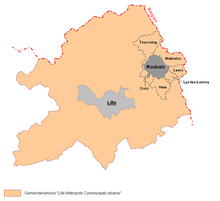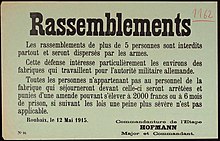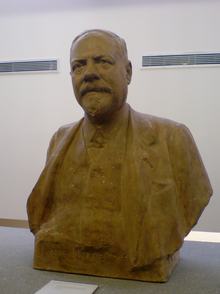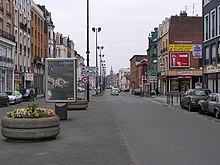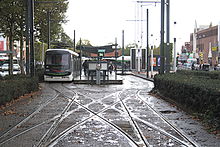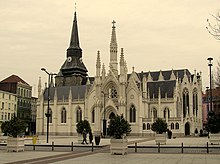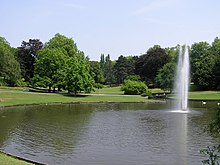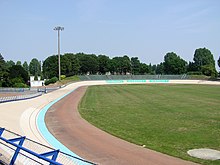Roubaix
| Roubaix | ||
|---|---|---|
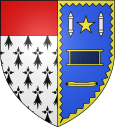
|
|
|
| region | Hauts-de-France | |
| Department | North | |
| Arrondissement | Lille | |
| Canton | Roubaix-1 , Roubaix-2 | |
| Community association | Métropole Européenne de Lille | |
| Coordinates | 50 ° 41 ′ N , 3 ° 11 ′ E | |
| height | 17-52 m | |
| surface | 13.23 km 2 | |
| Residents | 96,990 (January 1, 2017) | |
| Population density | 7,331 inhabitants / km 2 | |
| Post Code | 59100 | |
| INSEE code | 59512 | |
| Website | www.ville-roubaix.fr | |
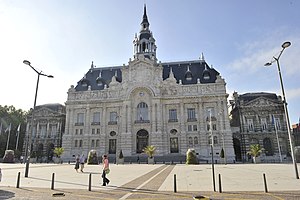 Roubaix Town Hall ( Hôtel de ville ) |
||
Roubaix [ ʀubɛ ] ( Dutch Robaais , older Roodebeke ) is a northern French town in Nord in the region of Hauts-de-France , near the Belgian border. In the past, Roubaix gained international fame as a textile center . Despite the collapse of the French textile industry, the city is an important training center for specialists in this branch and has also developed into a nationally important location for the mail order business. The city is internationally known as the destination of the famous Paris – Roubaix cycle race , one of the oldest and most famous one-day races in the world.
Together with Lille , Villeneuve-d'Ascq and Tourcoing , Roubaix forms a metropolitan area with around one million inhabitants and is part of the Métropole Européenne de Lille . Roubaix itself has 96,990 inhabitants (as of January 1, 2017), which are called Roubaisiens .
etymology
For the majority of etymologists, the name "Roubaix" stands for "Bach on the plain". It can be derived from the two Germanic words "Ros" / "Ross", describing a swampy or green plain, and "Bach" / "Bais". The origins of the city must therefore lie on the fertile banks of a stream, for example on the Riez de Favreuil or Trichon .
Regardless of its etymological meaning, the name Roubaix has been historically secured since the 9th century and occurs in numerous variations. However, the two most common forms of the city name during the early Middle Ages were Rosbais and Rosbacum .
geography
Geographical location
The city is located in a very flat landscape (30 meters above sea level) just under three to four kilometers from the Belgian border on the northeastern edge of the agglomeration around Lille, the capital of the Nord department. Neighboring communities are Tourcoing in the north-west and north , Wattrelos in the north-east, Leers in the east, Lys-lez-Lannoy in the south-east, Hem in the south and Croix in the south-west .
The center of Lille is about ten to twelve kilometers southwest of the city center of Roubaix via road links. The Belgian cities of Tournai (east) and Kortrijk (north) are each about 22 kilometers away. It is 215 kilometers to the capital Paris.
geology
Roubaix lies in a plane extending in the east-west direction syncline , the south and southeast direction Tournai for from Paleozoic limestone existing Mélantois-Tournaisis -Antiklinale increases. The depression in which Roubaix is located consists mainly of alluvial land of Holocene origin.
Only small watercourses such as the Trichon flowed in the urban area, which were heavily exploited and canalized by the industrialization of the city in the 19th century. A canal connection between the Deûle via the Marque and the Scheldt had to be established to ensure a secure water supply for the city , which was also supplied with water via a direct connection to Lille.
Urban geography
In the Middle Ages, Roubaix grew in a north-facing semicircle beyond the historic city center, which was around the square between the former castle and the Église Saint-Martin . This southern borderline was maintained into the 18th century. The city expanded mainly to the north and west. Industrialization and the resulting need for the development of cheap land for factories and workers' housing finally allowed the city to grow southward.
In the southeast of the city, the terrain rises slightly on the so-called Montagne de Barbieux , which only slightly delayed the expansion of the city in this direction. The municipality of Croix was formed on the opposite side of the flat hill.
The development of the city center is very angled due to its medieval origin. A geometrically planned layout of the urban area can be seen above all in the industrial and poorer working-class quarters around the city center.
Today's urban area is bounded in the east (partially), north and northwest by the Canal de Roubaix , which surrounds the city .
history
Roubaix was first recorded on a map as Robacum in AD 863 . At that time, the small town in Flanders was already part of the Tournai diocese . Its origins, however, go back to Roman times, when it grew into a fiefdom as the center of a large number of small settlements, which was administered and expanded by local rulers.
Especially in the 15th century, under the reign of Pierre von Roubaix, Roubaix grew into a city with the castle complex and the old church of Saint-Martin at its core . Their fate was closely linked to that of the houses of Burgundy and Flanders .
After the end of the House of Roubaix in the 16th century, the town and the surrounding feudal area were passed on from family to family by marriage. However, they remained the subject of the Flemish area of interest.
The cornerstone of Roubaix's industrial success during the 19th century was laid in 1469 when Charles the Bold granted the rights to manufacture and trade in textiles. Since then, the city has slowly grown into a regional and, in the course of the 19th century, a global center of the textile industry. Their nicknames “ Manchester of the North” and “City of a Thousand Chimneys” come from this heyday . The population increased fifteenfold during its industrial boom, which culminated in 1911 with the hosting of an international exhibition of the textile industry and as the seat of the wool exchange (now in Australia).
The economic climax of the Belle Époque was followed by a slump following the occupation during World War I. From October 14, 1914 to October 17, 1918 the Germans occupied Roubaix. They installed a tight management system.
“The occupying power confiscated all raw materials, as well as telephones and typewriters. They systematically looted all 250 factories in the city and destroyed what could not be removed. The Germans also wanted to assign the available labor. But the mayor Jean Lebas opposed this in 1915, who was then arrested. From April 1916 onwards, the Germans organized the deportation of the civilian population: more than 8,000 citizens of Roubaix became "voluntary workers" in the service of the occupiers. "
“The industrialist Eugène Motte was also one of the characters in this resistance. The… former mayor of the city refused in 1915 to make sacks for the Germans, which were filled with earth to be used to fortify their trenches. “We cannot take on the role of collaborators with the enemy. They can confiscate our property, but not our people. "This earned him arrest and a stay in prison in Germany, along with 150 other hostages from Roubaix."
Roubaix suffered a similar fate in World War II . A large part of the population fled the approaching German army - only 15,000 people remained in the city. During the occupation, Roubaix was an important regional center of the Resistance . Its former mayor, Jean-Baptiste Lebas, was arrested as a member of the Resistance and died in a German prison camp in 1944.
After the two world wars, however, a renewed upswing set in that lasted until the late 1960s. In the early 1970s, with cheaper international competition and the advent of synthetic fibers , the rapid collapse of the French textile industry began, resulting in significant unemployment across the region.
Structural change in the city began at the end of the 20th century . It has developed from the crisis into a regional trading center and is placing increasing emphasis on its own history, art and culture. Under the motto “la ville renouvelée” (German: the renewed city ), city beautification and modernization are tackled.
population
Roubaix is located in Nord , the most populous department in France.
For a long time Roubaix was the most populous of those cities in France that were not a prefecture of a department or a sub-prefecture of an arrondissement . In this regard, it is in third place today (2008) behind Villeurbanne and Montreuil .
| year | 1962 | 1968 | 1975 | 1982 | 1990 | 1999 | 2009 | 2017 |
| Residents | 112,856 | 114,547 | 109,553 | 101.602 | 97,746 | 96,984 | 95,028 | 96,990 |
| Sources: Cassini and INSEE | ||||||||
Population development
After Roubaix had been a provincial town until the late Middle Ages, its population increased to 8,091 in 1800 due to the growing importance of regional textile production in the 16th and 17th centuries. Due to the achievements of industrialization, there was a strong population growth in the 19th century : as early as 1842 the population was around 20,000 and exceeded 30,000 in the 1850s, until Roubaix finally had 124,000 inhabitants in 1900. The legal integration of Belgian residents (around 50% of the city's population at the time) and the steady increase in foreign job seekers from all over Europe and the Maghreb states promoted this growth. The economic crises in the textile industry and coal mining during the interwar period and the 1960s and 1970s led to a steady decline in the population.
The rapid population growth initiated a phase of urbanization and the formation of an agglomeration in the region between Tourcoing, Roubaix and Lille, which in 1967 led to the formation of the Métropole Européenne de Lille .
Population structure
Due to its industrial past, Roubaix is a true melting pot of the north. The proximity to the border led to a high proportion of Flemish immigrants. In addition, guest workers came from all over Europe (especially Portugal, Italy and Poland) from the 19th century and from the Maghreb ( French North Africa ) after the Second World War . In the past few decades, the proportion of people of Asian descent has also increased.
The proportion of foreign citizens, which was officially stated as 30% for people of Muslim religion, has become an important political and social issue for the city. There are estimates that the proportion of foreign residents is well over 80%.
language
Although the area several times under the rule during its history of Flanders was (→ See also: French Flanders ) , which remained French language consistently obtained as everyday language.
Roubaix is in the Picardy-speaking area . The French language is the language commonly used in everyday life; in addition, the expression called Roubaignot or Ch'ti of the Lille region is spoken in Roubaix; The Ch'ti includes, in addition to its own words, especially those relating to mining, and a multitude of differences in speech, a pronunciation of the sharp -s- as -sch-.
This dialect also became known in Germany from 2008 through the film comedy Willkommen bei den Sch'tis .
politics
Cantons
Roubaix is part of the arrondissement of Lille . Its communal territory is divided into two cantons :
Roubaix is also in 27/4 (quarters) divided.
Mayor of Roubaix
The following list contains the mayors of the city since 1901. For a full list see List of Mayors of Roubaix .
| Start of office | End of office | mayor | Political party |
|---|---|---|---|
| December 26, 1901 | January 26, 1902 | Edouard Roussel | UDR |
| January 26, 1902 | May 19, 1912 | Eugène Motte | FR |
| May 19, 1912 | March 7, 1915 | Jean-Baptiste Lebas | SFIO |
| March 7, 1915 | October 21, 1918 | Henri Therin | |
| October 21, 1918 | June 1940 | Jean-Baptiste Lebas | SFIO |
| June 1940 | August 17, 1941 | Fleuris Vanherpe | |
| August 19, 1941 | December 1941 | Marcel Guislain | SFIO |
| January 21, 1942 | May 1, 1942 | Alphonse Verbeurgt | |
| May 22, 1942 | July 1942 | Charles Bauduin | |
| July 18, 1942 (elected in 1945) | March 1977 | Victor Provo | PS |
| March 13, 1977 | March 6, 1983 | Pierre Prouvost | PS |
| March 6, 1983 | May 18, 1994 | André Diligent | UDF CDS |
| May 28, 1994 | March 13, 2012 | René Vandierendonck | PS |
| March 22, 2012 | March 30, 2014 | Pierre Dubois | PS |
| April 6, 2014 | - | Guillaume Delbar | LR |
In March 2008 René Vandierendonck from the Parti socialiste (List Roubaix Ensemble ) was confirmed in office with 55.43% of the votes. In the second ballot, he prevailed over the UMP (26.52%) and the Greens (18.06%) candidates .
Town twinning
|
- In addition, the " Collège Jeanne D'Arc" holds an annual exchange with the St. Thomas College in Vechta
The Goethegymnasium Weißenfels holds an exchange with the Lycee Boudelaire in Roubaix, which takes place every two years.
economy
The city owes its development to the textile industry , the importance of which has decreased significantly recently. As a result, the population has fallen sharply (see section Population ).
The local economy began to change at the beginning of the 20th century and was able to cope with the economic slump of the late 1960s and 1970s and a. to be partially absorbed by the new mail order market (French vente par correspondance , VPC). In this area, Roubaix grew into an important location throughout Europe and produced companies such as La Redoute , Auchan and 3 Suisses . Other locally significant shopping centers are L'Usine and the Mac-Arthur-Glen designer outlet .
traffic
City traffic axes
The main traffic axes in east-southwest direction are the Boulevard Gambetta and the Boulevard du Général de Gaulle , which arose along an old, but abandoned canal construction project. To the north, the main axes run along the boulevards Avenue Jean Lebas (connection to the train station), Avenue des Nations Unis and the Rue de Tourcoing . To the south, the three almost parallel streets Rue Louis Jouffroy , Rue de Lannoy and Rue Pierre de Roubaix should be mentioned in particular . The main traffic axes in the south-west direction to Lille are to be relieved via the expressway running along the canal (French voie rapide urbaine ), which leads to the A22 .
A fast connection to the cities on the Belgian side is only available via the A22 / E17 to Kortrijk . Tournai is only directly connected to Roubaix by country roads.
The city centers of Tourcoing and Lille in the north and south-west are not only indicative for road traffic, but also for rail traffic. There is a railway line as well as a metro and an S-Bahn line along these axes.
Long-distance transport
Roubaix is connected to a particularly dense network of motorways: in France from the south (Paris, Arras) the A1 and A22, from the south-east (Valenciennes, Cambrai) the A23 , from the north-west (Dunkerque) the A25 , in Belgium from the north ( Ostend, Bruges) the A17, from the northeast (Antwerp, Gent) the A14 and from the east (Brussels, Tournai) the A8.
Roubaix has a train station (Gare Jean Lebas) , which connects the city to the regionally important connection Tourcoing-Roubaix-Lille and from whose endpoints the access to the European rail network is made possible.
Local transport
| direction | Line 2 (Métro) | Line R (tram) |
|---|---|---|
| Tourcoing-Center / CH Dron |
Next station: Alsace (Tourcoing) |
|
| Gare Jean-Lebas | ||
| Roubaix Grand-Place | ||
| Roubaix Eurotéléport | Roubaix Eurotéléport | Roubaix Eurotéléport |
| Roubaix Charles de Gaulle | Alfred Mongy | |
| Épeule Montesquieu | Jean Moulin | |
| Hôpital Victor Provo | ||
| Parc Barbieux | ||
| Bol d'Air | ||
| Clinique du Parc | ||
| Gare Lille Flandre | Next station: Croix-Mairie (Croix) |
Next station: La Marque (Croix) |
Métro line 2 also runs through Roubaix, which also connects it with Tourcoing and via Croix and Mons-en-Baroeul with Lille, as well as the tram line R, which starts in Roubaix and in an S-shaped arc via Wasquehal and Marque -en-Baroeul leads to Lille (lines 2 and R cross in Wasquehal and meet again at Gare Lille Europe and Gare Lille Flandre stations ). The Roubaix Eurotéleport station on Boulevard Gambetta is the hub of these two lines in Roubaix. The public transport in the city is the public transport company Transpole settled.
Waterways
The Canal de Roubaix , which is currently being redesigned - financed by a European program ("Blue Links") - and is to be reopened to navigation in the course of 2008 , runs in an arc around the city . The canal, which was completed in the 19th century, was of great importance for supplying the local industry with raw materials and coal until the 1980s. It connects Roubaix with the Scheldt in the east and via the Marque with the Deûle in the west.
The almost 1.5 km long Canal de Tourcoing branches off from the Canal de Roubaix in the north-west of the city on the Quai des Mariniers not far from the Boulevard de la République in the direction of the city center of Tourcoing to the north.
Culture and sights
See also: List of Monuments historiques in Roubaix
In 2001 Roubaix was included in the list of “ French Cities and Countries of Art and History ”.
Secular buildings
The town hall of Roubaix
The first town hall of the city was set up in a renovated wing of the former Sainte-Élisabeth hospital with a portico and colonnades . The dilapidation of the medieval building and the growing demands of the city administration led to the construction of a new building by the architect Dewarlez in 1845. The town hall had its seat here for 60 years. In 1869 the “small town hall” (French: petit hôtel de ville ) was built the Grand'Place opposite the Saint-Martin church . It was built on the remains of the Sainte-Élisabeth Hospital .
The construction of a larger town hall was considered at the beginning of the 20th century. An agreement was concluded with the Chambre de Commerce (German Chamber of Commerce ), which was also looking for a new seat and had been housed in a wooden barrack since 1876. In 1903, the architect Ernest Thibeau from Roubaix designed the construction plans for the new building, which included a side wing for the Chamber of Commerce on the rue du Château side . When the foundation stone for the central town hall building was laid on November 24, 1907, the Chamber of Commerce was able to move into its new headquarters. Because of his poor health, Thibeau had to withdraw from the construction project that was given to Victor Laloux . Laloux had participated in the construction of the Orsay train station in Paris and the town hall of Tours and belonged to the architectural school of Beaux-Arts . He was assisted by the architect Dubois from Roubaix. Eight months after the project was handed over in 1905, Laloux presented a revised draft of Thibeau's plans.
The completed town hall building was inaugurated on April 30, 1911 by the Minister of Economic Affairs, who then opened the Northern France International Exhibition in Parc Barbieux . The mayor at the time, Eugène Motte, described the impressive façade during the inauguration ceremony with the following words: “We wanted the town hall's frieze to commemorate all the craft and trade bodies that make up the Roubaix symphony of industry. The six imposing bas-reliefs that crown the town hall mirror the everyday life of the residents. Wool combs, thread manufacturers, weavers, dyers, heavy workers, freight forwarders can recognize themselves in this work of all sculptors from the north [...]. "
One year after the inauguration of the new town hall, Motte died and the office passed to the socialist Jean-Baptiste Lebas. Eugène Motte, like other public figures in Roubaix, was immortalized in the mural “La charte des Drapiers” (1914) by Jean Joseph Weerts in the Pierre de Roubaix hall of the town hall.
The town hall was painstakingly restored in the 1990s and the facade was freed from the soot from industrial and traffic emissions in order to bring out its white stone from the quarries of the northern French town of Lezennes .
The station
The Roubaix train station (French: la gare de Roubaix ) opened on September 1, 1888 and, in addition to better connections to the local rail network, gave the rapidly growing city another architectural work of art. The station was built in the ornate Flemish style of the late 19th century (other examples include Arras (1895) and Tourcoing (1905) stations). The station building consists of a main hall with a height of 17 meters, the vestibule of which is illuminated by a wide front with windows. On the gable of the hall is a ten meter high campanile with clocks on three sides. There are neoclassical pavilions on both sides of the main hall . The large glazing at the rear of the station was destroyed during the retreat of the German troops in 1918 and was not restored afterwards.
Lengthy negotiations between the railway company and the city led to the construction of a road from the station to Grand'Place in 1911 . This axis, the avenue Jean-Lebas , which was expanded into a boulevard in 1946 , still dominates the old center of the city today.
The Roubaix cemetery
→ Main article: Cimetière de Roubaix
The cemetery , which was built in the middle of the 19th century due to the large expansion of the urban area and the enormous population growth in the east of the city, houses around 30,000 graves. It is especially worth mentioning and seeing because of its over 500 mausoleums , as it has the largest number of these burial chapels in Europe. With its richly designed tombs, it reflects the heyday of the textile and trade center of the late 19th and early 20th centuries.
Other structures
- The Vélodrome in the Parc des Sports is the destination of the classic Paris – Roubaix bike ride .
- The industrial monster of the industrialist Louis Motte-Bossut, which today houses the “Center of Archives for the World of Work” (French: Center des archives du monde du travail ), shows the efforts to bring the cultural heritage into the new face of the city to involve.
Sacred buildings
Saint Martin Church
The Église Saint-Martin , on the Grand'Place opposite the town hall, is the oldest building in the city and for a long time was the only church in Roubaix. Its origins are in the late 9th century, but there are no remains from this period. In the 14th century, the small and primitive church building was expanded by a hallekerk , consisting of three similar naves , which joined together to form a hall and supported a bell tower. In the middle of the 19th century, the church was expanded under the direction of the architect Charles Leroy and has since comprised five naves. The church houses a multi-colored, wooden, from Antwerp originating Altar of John the Baptist as well as several tombs with ornate cover plates, including the first ruler of Roubaix.
For the Portuguese community of Roubaix ', fairs are offered in Portuguese .
Other churches
In Roubaix are also the churches of Église Saint-Joseph (Rue de France) , the Église Saint-Jean-Baptiste , the Église Saint-François , the Église du Saint-Rédempteur (Quartier du Pile) , the Église Saint-Sépulcre (Quartier Epeule) and the Sainte-Bernadette chapel on Avenue Alfred Motte.
The Église Notre-Dame de Czestochowa was built on Grand-Rue for the Polish community .
Protestant churches can be found on Rue des Arts from 1871, Boulevard de Reims and Rue du Collège .
Other religious buildings
In Roubaix there are numerous mosques of the Muslim community. The largest is the La Sunna mosque on Rue Saint-Maurice . You will also find the Abou Bakr (Place Faidherbe) , Da'wa (Rue Archimède) , Arahma (Rue d'Anzin) mosques and prayer rooms on Rue Brame and in the Epeule district .
Roubaix is also home to two Buddhist temples: a Laotian pagoda on Rue de Tourcoing and a temple belonging to the Cambodian community. There is also another Vietnamese pagoda on Rue Daubenton .
Museums
The Musée d'Art et d'Industrie (German: Museum of Art and Industry ) is located in a former swimming pool in Art Deco style and shows in its permanent exhibition local and national art as well as the history of the local textile industry.
The Musée du Jaquard , which was created in the Manufacture des Flandres of the former Craye SA, provides an insight into textile production from the late 19th to the late 20th century. Craye SA was primarily known for the manufacture of jacquard fabrics and supplied, among others, Christian Dior . On a guided tour, visitors learn interesting facts about the upswing of Roubaix as a textile center, the protagonists involved, the working conditions at that time, the role of immigrants in the textile industry and the change in the cityscape.
Monuments
- The memorial to the members of the Resistance who fell in World War II in Roubaix.
- The monument to the industrialist, deputy and well-known mayor of the city, Eugène Motte (1860–1932) opposite the “Center of Archives for the World of Work”. A model of the monument can be found among the exhibits in the Museum of Arts and Crafts.
There are other monuments in the Roubaix cemetery , including one for those killed in industrial accidents and one for those killed in both world wars.
Parks and green spaces
In 2002, Roubaix was awarded four flowers by the Conseil national des villes et villages fleuris and was thus included in the list of villes et villages 4 fleurs . In addition, the city won the Grand Prix National de l'Arbre in the same year with the diverse and extensive tree population of the Parc Barbieux .
The Parc Barbieux is the green lung of the city. Numerous plant and animal species can be found on an area of 34 hectares. Beautifully designed promenades run along a lake landscape. The Parc Barbieux was created in 1878 from a tunnel construction site for the Canal de Roubaix . It is the largest urban park in France north of Paris.
There are also many smaller parks and green spaces in the city. For example, the Parc du Nouveau Monde in the Quartier de l'Hommelet with an area of 4.5 hectares, which is home to numerous exotic plant species as well as plants that were previously used to dye textiles . Or the former monastery garden Square de la Visitation , which is 13,000 m² surrounded by the high brick walls of a retirement home, but is open to everyone.
With the Jardin Chlorophylle , Roubaix has an educational garden in which visitors can learn about different types of plants and nature conservation.
More green areas
- The Square Catteau (13,500 m²) at the court
- The Parc du Brondeloire (3 hectares) in the Epeule district to the west of the city
- The Parc Cassel (14,200 m²) in the Alma district with predominantly regional plants
- The Square Destombes (10,500 m²)
- The Squares de Carihem (4,800 m²)
- The Squares de la Potennerie (10,000 m²)
media
Due to the close proximity and close links between the cities of the Lille agglomeration, numerous print media from the capital of the department are also read in Roubaix. These include B. La Voix du Nord Pays du Nord or Liberté Hebdo as well as other newspapers and magazines with a regional reference.
The daily newspaper Nord Éclair (originally Journal de Roubaix ) from Roubaix has its headquarters in the Rue du Général Sarrail . It was founded in 1856 as a Catholic daily newspaper on the initiative of the printer's owner Alfred Reboux. On September 5, 1944, the first edition appeared under the current name; she expanded her editorial area in the course of the 60s and 70s to the entire region and beyond the Belgian border (1961 in Tournai). In 1993 the Nord Eclair took over the daily newspaper Nord Matin and its readership. In 2000 the Nord Eclair was integrated into the media group La Voix du Nord .
Sports
In terms of sport, Roubaix is mainly known from cycling. The Roubaix cycle track ( Vélodrome in the Parc des Sports ) is the destination of Paris – Roubaix , one of the oldest and most famous “ one-day classics ” in the world. Roubaix produced successful athletes especially in this sport. So z. B. Charles Crupelandt (1886–1955), who emerged from the "Hell of the North" twice as the winner. The city of Roubaix has been a sponsor of the Continental Team Roubaix Lille Métropole since 2007 .
The football was in Roubaix also his highlights. Nowadays (2008) there is no football club from the city in one of the six highest leagues in France, but between 1900 and 1950 the city was one of the strongholds of French football : Racing Club , Excelsior AC and CO Roubaix-Tourcoing won championship and championship titles Cup to the city. In 1933, Excelsior and Racing, two teams from Roubaix faced each other in the cup final in Paris - Excelsior emerged victorious.
In the past, Roubaix was also able to achieve success in rowing. The four-man with helmsman of the rowing club Cercle de l'Aviron de Roubaix succeeded in winning the gold medal in the rowing competitions of the Olympic Games in 1900.
education
The city has only a few further institutions; however, there are numerous educational opportunities in their immediate vicinity, especially in the university towns of Lille, Villeneuve-d'Ascq and Courtrai on the Belgian side.
The textile university École nationale supérieure des arts et industries textile ( ENSAIT ), founded in the 19th century as Ecole nationale des arts et industries , over the years opposed two other institutes of the textile industry, the Institut technique de Roubaix (ITR, since 1885) and the Turgot Institute (since 1879). The ITR settled in Villeneuve-d'Ascq and was renamed ESTIT. ENSAIT now trains around 65% of French textile engineers.
The technical college École supérieur des arts appliqués et du textile (ESAAT) is in the immediate vicinity of ENSAIT. This state institution is complemented by a branch of the private international fashion school ESMOD on Boulevard du Général Leclerc .
In addition, several institutes from the Universities of Lille II (Droit et Santé) and Lille III (Université Charles de Gaulle) specializing in information and communication technology have established themselves in the city.
Inaugurated on September 30 in 1956 and 1973 by a native of Roubaix writer Maxence Van der Meersch named Lycée Maxence Van Der Meersch has a normal and a technical secondary school branch (Bac SLT) with training in biology. The school complex is also, not only because of its close proximity to the Vélodrome, heavily involved in young athletes - especially in cycling.
Personalities
- Jean Alavoine (1888–1943), cyclist
- Bernard Arnault (* 1949), entrepreneur and billionaire
- Marie-Christine Blandin (* 1952), politician of the French Greens and senator
- Alain Bondue (* 1959), cyclist
- Agnello van den Bosch OFM (1883–1945), Belgian religious, perished in the Dachau concentration camp
- Étienne Chatiliez (* 1952), film director and screenwriter
- Charles Crupelandt (1886–1955), cyclist and two-time winner of the Paris – Roubaix race
- Stanislas Dehaene (* 1965), neuroscientist and professor at the Collège de France
- Georges Delerue (1925–1992), film composer
- Arnaud Desplechin (* 1960), filmmaker
- Raymond Dubly (1893–1988), national soccer player
- Raymond Guiot (* 1930), flautist and composer
- Pierre Jansen (1930–2015), composer
- Prudent Joye (1913-1980), track and field athlete
- Anthony Knockaert (* 1991), soccer player
- Jean-Baptiste Lebas (1878–1944), mayor of the city and fighter of the Resistance
- Philippe Lefebvre (* 1949), organist
- René Libeer (1934-2006), boxer
- Louis Loucheur (1872–1931), politician and co-founder of today's Vinci company
- Georges Malfait (1878-1946), track and field athlete
- Martial Mbandjock (* 1985), former sprinter
- Octave Merlier (1897–1976), Neo-Greekist
- Eugène Motte (1860–1932), important industrialist and mayor of the city
- Ghislain Muller (* 1950), jazz musician
- Gérard Mulliez (* 1931), entrepreneur and manager
- Vianney Mulliez (* 1963), entrepreneur and manager
- Moussa Niakhaté (* 1996), football player
- Idir Ouali (* 1988), French-Algerian football player
- Pierre Pflimlin (1907–2000), doctor of law and politician
- Jacques Pollet (1922–1997), racing car driver
- Antoine Roussel (* 1989), ice hockey player
- Raymond Schmittlein (1904–1974), general and politician
- Maxence Van der Meersch (1907–1951), writer
- Marcel Verfaillie (1911–1945), communist and resistance fighter against National Socialism in World War II
- Gaby Verlor (1921–2005), chansonnière and composer
- Théodore Vienne (1864–1921), sports official, industrialist, sports organizer, patron and sports journalist
literature
- Philippe Waret and Jean-Pierre Popelier: Roubaix de A à Z . Editions Alain Sutton, Saint-Cyr-sur-Loire, 2006, ISBN 2-84910-459-0
- Michel David (inter alia): Roubaix: cinquante ans de transformations urbaines et de mutations sociales . Presses Universitaires du Septentrion, Villeneuve-d'Ascq, 2006, ISBN 2-85939-926-7
Web links
- Official website of the city of Roubaix (French, English)
- City history website (French)
- Website of the tourist office of Roubaix with a lot of information about the city (French, English)
- LeBlog2Roubaix video blog about Roubaix (French)
- La FABRIQUE Internet platform for the democratic participation processes of the citizens of the city (French)
Individual evidence
- ^ De Nederlanden in Frankrijk, Jozef van Overstraeten, 1969
- ↑ Théodore Leuridan: Histoire des seigneurs et de la seigneurie de Roubaix , p. 21 ff.
- ↑ Archive link ( Memento of the original dated November 24, 2012 in the Internet Archive ) Info: The archive link was inserted automatically and has not yet been checked. Please check the original and archive link according to the instructions and then remove this notice.
- ↑ a b http://www.wegedererinnerung-nordfrankreich.com : [1]
- ↑ Forced labor, hostages and deportation ( page no longer available , search in web archives ) Info: The link was automatically marked as defective. Please check the link according to the instructions and then remove this notice.
- ^ Philippe Waret and Jean-Pierre Popelier: Roubaix de A à Z. p. 36 and p. 150
- ^ Philippe Waret and Jean-Pierre Popelier: Roubaix de A à Z. p. 177
- ↑ Luc Gruson: L'Islam en France. ADRI, 2000, ISBN 2-11-004646-5
- ↑ Jonathan Laurence and Justin Vaïsse: Intégrer l'islam. P. 40, Odile Jacob, 2007, ISBN 978-2-7381-1900-1
- ^ Jacques Landrecies, Aimé Petit: Picard d'hier et d'aujourd'hui . In: Center de Gestion de l'Édition Scientifique (CEGES) (ed.): Bien dire et bien aprandre - Bulletin du Center d'études médiévales et dialectales de l'Université de Lille III . No. 21, Villeneuve d'Ascq, F, April 1, 2003, p. 11. ISBN 978-2-907-30105-3 . Retrieved on September 26, 2015. "… aborder le difficile Problem de l '" accent ", cette dernière marque qui subsiste quand le patois a disparu et qui, plus que tout, permet de distinguer l'Abbevillois de l'Artésien ou du" Roubaignot "."
- ↑ Timothy Pooley: Chtimi: The Urban Vernaculars of Northern France (= Applications in French Linguistics Series). Multilingual Matters Ltd., Clevedon, UK December 30, 1996, ISBN 978-1-853-59345-1 , pp. 104-140 (accessed September 30, 2015).
- ↑ Report on the outcome of the 2008 local elections in Roubaix ( Memento of the original from March 18, 2008 in the Internet Archive ) Info: The archive link was inserted automatically and has not yet been checked. Please check the original and archive link according to the instructions and then remove this notice. of March 17, 2008. On www.nord-pas-de-calais-picardie.france3.fr
- ↑ Detailed results of the 2008 local elections in Roubaix at www.linternaute.com
- ↑ “Nous avons voulu que la frise de l'hôtel de ville rappelât tous les corps de métier et de négoce qui forment la symphonie du travail roubaisien. Les six bas-reliefs imposants qui couronnent l'hôtel de ville sont le miroir même de la vie quotidienne des habitants. Peigneurs, filateurs, tisseurs, teinturiers, hommes de peine, expéditeurs peuvent se mirer dans cette œuvre de tous les sculpteurs du Nord […]. ” Eugène Motte on April 30, 1911. From: Philippe Waret and Jean-Pierre Popelier: Roubaix de A à Z , p. 98f
- ↑ Report on the Musée du Jaquard ( Memento of the original of December 3, 2008 in the Internet Archive ) Info: The archive link has been inserted automatically and has not yet been checked. Please check the original and archive link according to the instructions and then remove this notice. on www.lillemetropole.fr (French)
- ↑ Textile industrial history in Roubaix ( Memento of the original from December 4, 2014 in the Internet Archive ) Info: The archive link was inserted automatically and has not yet been checked. Please check the original and archive link according to the instructions and then remove this notice. . Travel EXCLUSIV magazine website, accessed November 27, 2014.
- ↑ Entry on Roubaix ( Memento of the original from August 28, 2008 in the Internet Archive ) Info: The archive link was automatically inserted and not yet checked. Please check the original and archive link according to the instructions and then remove this notice. on the website of villes et villages fleuris (French / English)
- ^ History of the daily newspaper Nord Eclair on www.nordeclair.fr (French)

